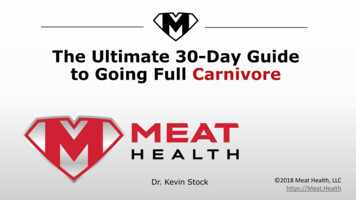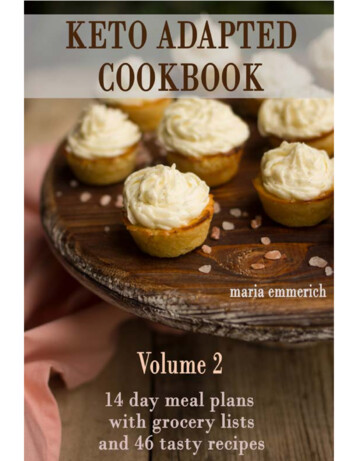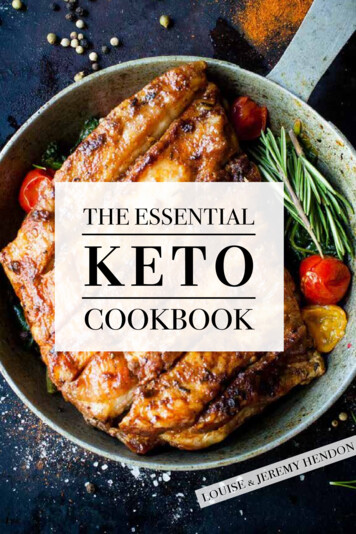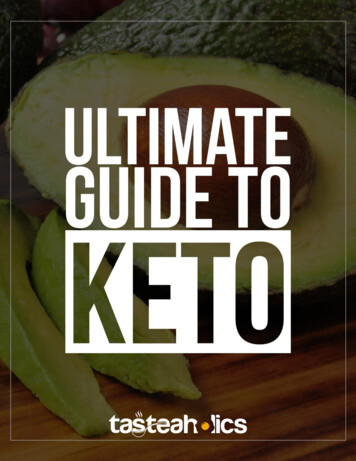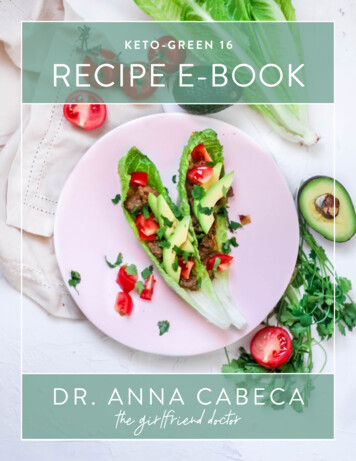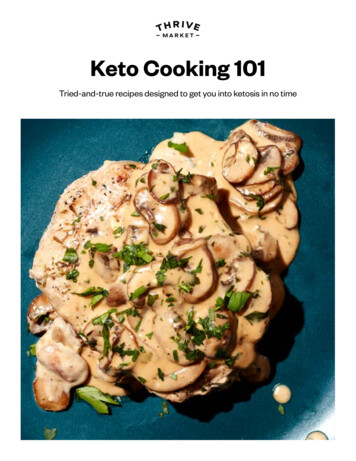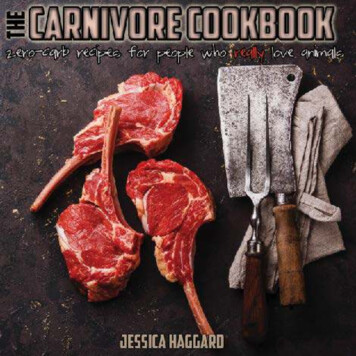
Transcription
The CarnivoreCookbookzero-carb recipes for people who really love animalsJessica Haggard
To those who fearlessly stand up to evil, love their families, and protect the culturaltradition and history of human beings. Cheers to all who #EatMeatMakeFamilies.No part of this book may be reproduced or transmitted electronically in any form or by any means, electronic ormechanical, including photocopying, recording or by any information storage and retrieval system, without writtenpermission from the author. As an eBook, you may print a personal copy for private use only.This book contains information that is intended to help the readers be better informed actors in their own healthcare. All information herein is presented as general advice; a person should always consult their trusted medicaladvisor for individual needs.All recipes, images, and text 2019 Jessica Haggard.
ContentsEat MeatCHAPTER ONEFats & SaucesCHAPTER TWOEggsCHAPTER THREEPoultry & PorkCHAPTER FOURFish & SeafoodCHAPTER FIVE Muscle MeatsCHAPTER SIX Raw Meat, Organs & BonesGlossaryResourcesRecipe Index
Eat MeatOur days of timidly consuming animal foods and restricting meat intake areover. The veil has lifted. The emperor wears no clothes and the peasantry canplainly see how frail and weak his frame has become from all the soy.The normalization of processed, refined, corporate Disney junk food hasushered in an age of rampant diabetes, autoimmune conditions, degenerativebrain diseases, obesity, and depression. It has disconnected us from thewisdom of our ancestors who knew how to nourish their families using locallyprocured animal fats and protein.“The peasantowning hisown land,the fishermanowning hisboat, althoughobliged towork hard, are,nevertheless,masters ofthemselves andof their time ”Alesis Carrel,1935It is time to take responsibility for our our own health and the health of ourfamilies, communities, and cultures. It is time to take back our kitchens onemeaty meal at a time.True human nutrition is based around heritage animal foods: meat, fish andseafood, organs, eggs (when available) and animal fats. Seasonal tubers andplants, often requiring careful, time-consuming preparation, as well as fruitsare ancillary components. Contemporary diets of industrialized areas arenoticeably devoid of these important foods, instead misinformed people favorlow-fat dairy, processed whey protein or worse, plant-based protein powders,refined grains, and extreme amounts of processed sugars.“And bringhither the fattedcalf, and kill it;and let us eat,and be merry.”Luke 15:23Eat Meat7
A Carnivore Style Diet“After notconsuminganimal productsfor four yearsand thenswitchingover to ameat based,carnivorous dietI experienced abig difference inmy mental andphysical health.The declinein health wasdrastic duringmy vegan yearsand I neverthought meatwas one of themost importantmissingingredients torecover it. Itgave me backmy life!”Kristel8A diet based completely on animal foods? Blasphemy! The basic assumptionin the West for at least the last 100 years has been that plant foods arenecessary for health. While the recent popularity of low-carbohydrateand ketogenic diets led many to question and discard old dietary dogmaconcerning saturated fat and animal foods, the so called “carnivore diet”is taking a sledgehammer to the glass house of the mainstream nutritionaltheories perpetuated by perceived authorities. People are not just survivingon an all animal food diet, we are thriving.Some gravitate to a carnivorous approach to food due to health conditions noother diet or lifestyle changes were able to remedy. Others just love eatingmeat and are sick of the damn vegetables. Functioning as an eliminationdiet, everything from normalizing thyroid levels, pain relief, reducing anxiety,eradicating depression, improving skin health, long-term fat loss, reversingauto-immune conditions, and recovering from disordered eating have beenexperienced.There is no monolithic, one-size-fits-all way to go about the “Carnivore Diet”.At the bare bone, the diet revolves exclusively around essential nutrients –protein and fat from animal-based sources. Some individuals do fine with awide spectrum of meat, fish, eggs, and dairy; others do best with a narrow listof only red muscle meat, salt, and water; still others enjoy nose-to-tail eatingwith a focus on nutrient dense organs and fat soluble vitamins.Carnivore heretics are proving something simple and highly controversialabout nutrition. If we strip out all nonessentials from the human diet there isone group of foods that is absolutely necessary for human health and survival,there is only one group of foods that man can live on exclusively withoutsupplementation – animal foods. Man cannot live by bread alone, but hisbody can thrive on MEAT alone.The Carnivore Cookbook
Raw MeatIt’s not for everyone, but it can be done. Any muscle meat can be eaten raw;parts from the loin (tenderloin, sirloin, and tri-tip) are excellent. Many findthat chilled rather than room temperature meat is preferable. To serve, slice into bite size pieces or cut one large section and chew off pieces directly. Bestwhen eaten with hands. Get fresh, clean meat from a good source.PREPARE YOURSELF1. Start cooking your steaks very rare. Gradually get used to the taste andtexture of rare/raw meat.2. Try a small piece of raw meat (like an appetizer) while you prepare acooked dish.3. Have a larger portion or an entire meal of raw meat when you are veryhungry. Raw meat is excellent dipped in melted fat. Sprinkle with salt asdesired.Beautiful ButterNo two butters can be exactly the same. The breed of cow, diet,and seasonal conditions inform the taste, texture, and appearance ofeach batch. There is a direct link between what the cow eats and theflavor of butter. As well as, how the cream is handled and churned.Historically, butter is a seasonal food made when cows are pasturedin fresh, quick growing grassy areas. Winter butter, usually fromcows fed grains, hay and dried herbal supplements, literally pales incomparison to the bright yellow color and soft fluffy texture of springand summer butter.Animal fatsoccupya uniqueposition in thepharmacopeiaof Chinesemedicine.Sourced froma large varietyof animals(domestic andwild), they sharea commonindication of“replenishing”for themalnourishedor debilitated.Anothercommonuse is for skinconditions likevarious typesof injuries andinfections.“Don’t eatanything yourgrandmotherwouldn’trecognize asfood.”Micheal PollenEat Meat9
Changing Perspective“And Abel, healso brought ofthe firstlings ofhis flock and ofthe fat thereof.And the LORDhad respectunto Abel andto his offering.”Genesis 4:4Nose-to-taileating is nota blood lust,testosteronefueled offalhunt. It’scommon sense,and it’s all goodstuff.FergusHendersonWe’ve been duped. Years of conditioning via media propaganda hasprogrammed us to fear the most essential, easily digested, and nutritionallycomplete foods. How many of us handle meat as if it’s unclean or dangerous?How many of us have wrecked our own health by removing these heritageanimal foods from our diet? Has there ever been a time in history whena culture has been so confused about how to nourish themselves and theirchildren?Quit cringing when you handle animalfoods! Meat isn’t unclean and it isn’tunhealthy. Most of the world shops formeat in open-air markets where locallyraised animals and fresh seafood arehandled openly, without gloves orprotective eyeglass and hazmat suits.Only in recent years have prepackaged,plastic wrapped meats been the norm.Gone are the days of daintily handlingflesh, never again shall we guiltily dine onmeat. Animal lives matter. We respect andappreciate their existence, our healthdepends on them!What many think of as blood is onlythe interstitial fluids. Us meat eaters getvery little actual blood on our hands.Don’t be afraid to touch, poke and prodmeat.Pieter Aertsen The Cook, 155910The Carnivore Cookbook
Hunting in the Modern WorldWe put an emphasis on quality by listing ingredients as “free-range organiceggs”, “raw heavy cream”, and “grass-fed beef liver”. We aim for grass-fedmeats, wild-caught fish, and free-ranged poultry.Is it possible to eat like this 100% of the time? Not for everyone. Our foodchoices are determined by budget and availability. Plenty of people consumeconventionally grown meats and do very well. A fast food burger will alwaysbe better than a soy burger!Be patient and stay motivated as you learn to “hunt and gather” the bestingredients for yourself and family.We encourage you to get as close as possible to your source of food. Thereare a number of ways to connect with food producers. Visiting a farmer’smarkets is an excellent first step. Ask venders at a farmer’s market torecommend local co-ops and buying clubs. Look into “cow sharing” programswhich enable you to purchase beef in bulk by splitting a cow with a fewfriends or neighbors. Crowd Cow is based on the same concept but facilitatedbetween a larger number of people allowing you to make a smallerinvestment of money and freezer space. Celebrate whatever high-quality,fresh animal food sources your area has. See Resources section to learn more.Your Most Valuable AssetForm a relationship with your butcher, they make great friends. Soak up asmuch knowledge from them as you can. Many meat departments will divide awhole chicken for you, chop a cheap roast into stew meat, grind heart or liver,and remove the bones from a whole fish. They can also special order cuts ororgans and contact you with time sensitive deals.“Raising goatshas shown methe remarkableability of theruminantanimal to takenutritionallypoor, fibrousand inedible(to us) plantmaterial andconvert it to themost nutritionallydense, vitaminrich food. OnceI gained thisappreciationand decided toconsume mostlyanimal basedfood insteadof plants, myhealth and wellbeing improvedbeyond whatI thought waspossible.”DawidCymermanEat Meat11
If the farmer ispoor then sois the wholecountry.Polish Proverb“La carne enmi vida significamás allá demi trabajo yel sustento demi diario vivir.Es de granimportanciapor la proteínaque tiene yaque ningúnalimento igualaa la proteínaque ésta tienepara nos. Comocarnicero,alimentomuchoshogares con misanimales.MarcellaCevallos12Peter Aertsen Butcher’s Stall with the Flight into Egypt, 1551Is it good still?In general, cooked food kept in an air tight container, will last for 3-5 days inthe fridge. Some foods may be preserved until 7 days. If you have animalsaround, they make great composters for overly ripe meat. Dogs, cats, andchickens all love funky meat!Signs that meat is spoiled: Slimy or sticky to the touch Brown, wilted looking meat Pat the piece dry and smell it, is it sour? Trust your nose!The Carnivore Cookbook
Under Appreciated Budget Cuts of MeatThese choices are not as soft or tender as high-quality (high-priced) ribeye,tenderloin, and T-bones but cooked right, they can be enjoyed just as much,if not more since they cost less. Sear steaks rare to avoid chewy overcookedmeat. You may need to special request these cuts.CHUCK EYE STEAKS called the “poor man’s ribeye” from the chuck of the cow.Good for grilling.CHUCK TENDERS, also called “mock tenders”, look like tenderloin but aresmaller and much more affordable. Best to salt heavily overnight beforecooking. Good for grilling.TRI-TIP from the bottom sirloin. Grill, slow-cook, or see recipe. Great foreveryday steaks.HANGER STEAK, also called “butcher’s steak” because the butchers usuallyGoat is a veryviable sourceof nutrition.Cook the sameways as lamb;sear chops,roast a leg, orbraise in broth.Not commonlyfound in the islesof supermarkets,this meat canbe sourcedfrom a localneighbor,farmer, orfriendly farmer’smarket vender.keep it for themselves, from the cow’s belly. Great flavor and tender but witha long membrane running down the middle. Sear on high heat.FLAP STEAK, also called “sirloin tips”, from the bottom sirloin. Thin with goodflavor.FLAT IRON STEAKS from the chuck or shoulder. See recipe.EYE ROUND STEAK from the round. Easy to overcook! Grill, slow-cook, orbraise.Organs arecheap,delicious, notdifficult toprepare, andoffer nutrientsunavailable insuch incrediblequantitieselsewhere.CHARCOAL STEAKS from the top of the cow’s shoulder. A piece of gristle runsthrough the middle, eat around it.Eat Meat13
18 Ways to Get Meat For Cheap1. Prioritize what you value most in your home and lifestyle. Review your budget, is therean area you can reduce the cost in favor of more quality foods? Are you still paying forcable TV and a Netflix subscription that you don’t use? Can you make a coffee at homeinstead of paying double from the coffee shop? Are you purchasing unnecessary snacks?2. Eat organ meats! Ask your butcher to special order the pieces you want if they are not instock. Grind liver and heart, mix it in with ground beef, pork or other meat for burgers,meatloaf, and mince.3. Frozen meat is often cheaper than fresh.4. Dark meat is usually more affordable than light (chicken thighs vs. chicken breast). Whitefish is usually cheaper than salmon and tuna. Seek out lesser known varieties.5. Pick up a 60-pound case of the best quality meat you can find at Costco and split itbetween friends and/or other families.6. Call your local supermarket to inquire when they mark down their past-prime, best buydate on meats. You can score meat that’s ready to be made right away for less. Eitherfreeze immediately or cook soon after bringing home.7. Plan around supermarket BOGO (by one, get one) sales. These are brand specific andoccur periodically. Stock up when you can, special order a large amount before hand ifyou know of an upcoming sale.8. Search Craigslist.org for sale farm & garden for animals getting prepped forslaughter. Small family farms and homesteads announce upcoming meat harvests. Detailsand contact information are available within each post.14The Carnivore Cookbook
9. Raise a flock of backyard chickens for eggs or meat. It’s easy and so rewarding!10. Buddy up with your butcher. More often than not if you ask for the best deals on meatsthey will be more than happy to share what they know.11. Support the local 4-H club and purchase meat by auction at the County Fair. Commonpractice includes bidding on a live animal and paying an additional fee for processing.Beef, mutton, and pork are all available. Throw down on big buys with friends.12. Whenever there are seasonal promotions (like turkeys in November) stock up on as muchas your freezer allows.13. Participate in Animal Science or Meat Science programs at a local college. They mayhave a retail store, offer butchering classes, or process meat on site at the campus.14. Buy a whole animal whenever possible; whole chicken, turkey, and fishes are easyenough. Goats are possible, cows are usually best split between another family or two.Whole poultry will give enough meat for a few meals and bones to simmer into brothafterward. If you buy whole fish, learn to fillet it yourself or ask the friendly face behindthe counter for help. Save the heads and bones for stock.15. Hit up your hunting buddies! Ask if you can buy some wild meat or fish from local huntersand fisherman.16. Tougher meats are always going to be cheaper. Use these for slow-cooking in a crockpot.17. Sign up with local co-ops and cow share programs. See Resources for more.18. Tune into local resources unique to your area. Do you live in a good hunting area? Areyou on the coast? Look for post-seasonal deals whenever and wherever possible. Alwaysask if there are any upcoming sales!Eat Meat15
Primal CutsTypically bonein, skin-onoptions are moreaffordable.These pieces arenutrient denseand have greatflavor!Cookingtough, hardworking musclestransformsthem into soft,gooey, nutrientdense bits offood coated incollagen andgelatin. Choosechuck, bonein short rib,bottom sirloinflap (bohemian),fatty brisket, andcross-cut shanksfor the stew pot.16Animals are divided into large sections called primal cuts. These primals arethen separated into subprimal cuts and again into individual retail cuts, whichis what you find at the store.CHUCK from the forequarter made of neck, shoulder, and upper arm. Theseare all lean, hard working muscles, tough when overcooked. Secondarycuts include ground chuck, flat-iron steak, chuck short ribs, shoulder tendermedallions, stew meat, and top blade steak. Larger cuts are excellent forstewing and pot roast.BRISKET is the pectoral muscle, an extremely flavorful and moderately fattycut best for pot roasts and corned beef. Prepare in a slow-cooker, barbecue,or smoker.SHANK is located on the fore and hind legs. It is one of the toughest sections:sinewy, meaty, and collagen rich. Perfect for slow cooking, braising, andstewing.The Carnivore Cookbook
RIB contains the sixth through twelfth ribs (other ribs in are in the chuckcut) consists of the traditional standing rib roast, ribeye steaks, entrecote,Delmonico steak, and cowboy steak. Use for grilling, frying, broiling, roasting,or barbecue.PLATE from the abdomen, includes short ribs and skirt steak. Braise short ribsin broth and grill skirt steak. Plate also makes very good ground beef withhigh fat content.LOIN runs from the thirteenth rib back to the hip bone and from the spinedown to the flank. It is divided into two subprime parts: shortloin and sirloin.Shortloin houses most of the popular steaks: T-bones, porterhouse, strip loin,strip steak, tenderloin, and filet mignon. Secondary cuts of sirloin include topsirloin, bottom sirloin, tri-tip, ball tip, and flap. Sirloin steaks are boneless;good for grilling, roasting, and barbecuing.FLANK rests next to the plate along the belly of the cow. Common cuts areflank steak and London broil. Grill quickly over high heat. Flank may also bebraised; in some cases it is used for ground beef.ROUND comprises the back leg of the animal and rump. Typical ofhardworking muscles, these are lean and inexpensive cuts. The large sectionis separated into secondary cuts of round steak, top round, bottom round, tiproast, knuckle, rump roast, and eye of round. Also used for ground beef.“No era in the long journey of mankind reveals in the skeletal remains sucha terrible degeneration of teeth and bones as this brief modern periodrecords.Nature in her long large-scale human demonstration revealsthat this is chiefly the result of inadequate nutrition of the parents and toofrequent or too prolonged child bearing.”Who would ofthought thatswitching toa carnivorelifestyle wouldhave so manypositive benefitsand be so easyto do. I havebattled withmy weight allmy adult life,and tried manydifferent diets;nothing hasworked like acarnivore diet.In four monthI was able tolose 38lbs, allinflammation inmy joints and,most important,my depression isgone. I’ve neverfelt this goodas far as I canremember.Fred S.Weston A. Price, Nutrition and Physical DegenerationEat Meat17
We will not giveup our rightsto healthynourishing food.We will notgive over ourchildren, ourcultures, ourheritage, ourwater, our land,and our Godgiven rights. Wewill eat meatand makefamilies.I feel so clearheaded [eatingCarnivore] andI see it withmy family too.When stresshappens, it isa lot easier todeal with. Wecan focus onwhat mattersinstead ofthinking aboutfood. It’splanned outand the budgetis set, simpleand easy.Kamie Y18JOWL from the front end, an important ingredient for head cheese andsausages.BLADE SHOULDER sometimes called the Boston butt is located on the uppershoulder and includes the neck, shoulder blade, and upper arm. Use forroasts, stewing, braising or steaks. Excellent for ground pork and sausages.Fatback can be found just above the shoulder, add to ground meat or renderinto lard.ARM SHOULDER is tough, commonly cured or smoked. Also can be used forground pork and sausage.LOIN includes baby back ribs, tenderloin, cutlets, and chops. Roast, grill,braise, or sear. Another second section of fatback is here; use for lard.HAM emerges from the tail end of a hog. Use for ham steaks and fresh,cured, or salted hams. Ham hock is where the bottom join of the ham connectswith the foot.SIDE is the infamous pork belly. Can be roasted whole, cured like pancetta, orThe Carnivore Cookbook
made into bacon.SPARERIBS nestle between the loin and side. Excellent grilled, braised, orslow-cooked.Cookedchicken legbones andthin cut beefmarrow bonesdouble asteethers forbabies to gnawon!FOOT like all feet, are very collagen rich – add to the broth pot.WINGS are the arm of the bird, made of a mixture of fat, meat, and skinsurrounding a few small bones. Sold bone-in, with skin. There are threesegments: the tip, flap, and drumette. As the smallest part of the bird, theyare not exceptionally meaty but make up for that with flavor. Oven-bake, fry,roast, grill or barbecue.BREAST is white meat from the chest, probably the most popular part of thechicken. Best with skin on. Versatile; pan-fry, bake, roast or barbecue.DRUMSTICKS are part of the leg up to the thigh and always come on thebone. Easy to cook; grill, bake, or slow-cook.“Goose greaseand fine lard arethe only creamspermitted in thedairy, both forthe dairymaids’hands and thechurn fittings.They are alsoused in eastwinds or snow,to anoint theudders of cowsto preventchapping.”Dorothy HartleyTHIGHS have darker meat that turns juicy and tender but needs a little longertime to cook than white breast meat. Sold with skin, thighs are the upperEat Meat19
part of the leg that connects to the body of a chicken. Bone-in and bone outoptions available. Roast, slow-cook, or braise.“So give to me,I only beg,A little roof tocall my own,A little cider inthe keg,A little meatupon the bone;A little gardenby the sea,A little boat thatdips and swings.Take wealth,take fame, butleave to me,O Lord of Life,just Little Things.- The Joy of LittleThings, RobertWilliam ServiceButter spoils nomeat.Danish proverb20WHOLE CHICKEN is the entire bird, all the parts listed above. Buy precookedor fresh; organs and giblets are removed. Poach, roast, or slow-cook; save thecarcass and all bones for broth.LEGS combine drumsticks and thighs together in a whole leg, sold bone-inwith skin-on. Affordable, with great flavor. Excellent for grilling, roasting, andstewing.SPLIT CHICKEN BREAST sometimes called bone-in chicken breast, comes skinon. Meat is same quality as mentioned above, here it comes with the bone.Good for soups and roasting; can be stuffed.How to Divide a ChickenPlace the body on a cutting board, breast side up, pull 1 legaway from the body and cut down through the skin between thethigh and body. Bend thigh back until hip joint breaks. Cut throughjoint, separating the leg from the body. To separate the thigh anddrumstick, slit the skin above the knee joint, break the joint, then cutapart. Repeat on the other side.Next, peel the wing away from the body and bend it until the jointbreaks. Cut it free. Repeat on the other side. Using kitchen shearsor a sharp knife, cut down the length of the chicken through the ribbones toward the neck, separate the breast from the back. Repeaton second side, separate two sides and cut breast lengthwise awayfrom bone.The Carnivore Cookbook
Frans Snyders Kitchen Still Life, 1605Organ MeatsMuscle meat is delicious. We all know that. But did you know the most nutrientrich parts of the animal, those prized by indigenous cultures, are also the mostaffordable and neglected parts in our modern world?Don’t just eat steak, eat the organ meats too.If you were to take responsibility over an animal’s life, commit months of yourown life tending to and caring for it, then butcher and process all useableparts – you want to harvest as much as possible, letting little go to waste. Ifyou hunt and have the skill enough to get a kill, you want to bring it all home.For us, the same principle applies even when someone else raises the beast.“Nose to tail” eating is deeply nourishing. Skip the multi-vitamins based on“For millenniapeople haveknown to maketheir food.They haveunderstoodanimals andwhat to do withthem, havecooked with theseasons, andhad a farmer’sknowledge ofthe way theplanet works.They havepreservedtraditions ofpreparingfood, handeddown throughgenerations,and have cometo know themas expressionsof their families.People don’thave this kindof knowledgetoday, eventhough it seemsas fundamentalas the earth.”Bill BufordEat Meat21
“I’m surprisedby how manypeople ask forodd bits; it’s apleasure whencustomers buycuts I didn’t thinkwe’d sell.”Stanton,Artisan Butchersynthetic and petroleum-derived compounds and eat offal a few times aweek instead. The abundance of bioavailable vitamins, minerals, fats, andamino acids found in organ meats is incredible and will serve you better thanany supplemental vitamin pill. Quality organ meats provide ample vitaminA, B complex, D, E, K2, folate, and minerals such as iron, copper, manganese,phosphorous, selenium, zinc. Certain fat-soluble vitamins, essential to ourhealth, are impossible to find in any plant-based foods.High in nutrients, yet low in price only because demand is minimal, notbecause they aren’t worth buying! Even from grass-fed/organic sources, organmeats, suet, and bones are usually very affordable. Be resourceful in your“hunting”; purchase from local farmers or ethnic markets. Always buy in bulkwhen you find good deals and freeze what you do not immediately use.If you can’t source local offal, visit US Wellness for a variety of poultry parts,beef and bison bits, as well as organ meat sausages (a great option if youwould like to “disguise” your offal).The decline inuse of organmeats is acultural voidthat reflectsthe shallownessof moderncuisines in favorof superficialnourishment,frivolousaesthetic,and inferioralternatives.Ancestral SupplementsIf you need to ease yourself into the wonderful world of offal andjust can’t stomach the meats yet, use Ancestral Supplements blends.We’d be grateful if you purchasing using our affiliate link so theyknow we sent you!LiverOunce for ounce, liver is the most nutritious food on earth. This organ provideshigh-quality protein, notable vitamins (A, D, E, K, amd B12), carnitine, lipoicacid, folate and choline. There’s no better source of retinol, the fat soluble22The Carnivore Cookbook
form of vitamin A found only in animal foods.Traditional hunters often eat the raw liver from their kill on the spot. Onepractice shared between many cultures, is to divide the raw liver among thewhole group for all to benefit. Apex predators, such as lions, eat the liver first.Sometimes predators don’t even bother with the muscle meats, leaving themfor beta members of the pack or scavengers instead.Raw liver and liver pate are great ways to try liver for the first time.Isn’t liver where all the toxins go?The liver works to neutralize toxins but does not actually store them.Poisonous compounds that the body cannot neutralize or eliminateare lodged in the fat cells and fatty tissues. The liver is not astorage organ for toxins; it is a filter. Purchase organs from healthy,grass-fed animals – beef, veal, sheep, lamb, buffalo, hogs, chickens,turkeys, ducks, and geese. Cod livers, canned in their own oil, arealso excellent.HeartHeart has a high concentration of coenzyme Q10 (CoQ10), a nutrientnecessary for the basic functioning of cells. CoQ10 levels decrease with ageand regular use of statins. The dense muscle also contains fair amounts ofprotein, selenium, phosphorus, and zinc. It is quite lean, with lots of collagenand very little fat.Easily ground, heart can be mixed with ground muscle meat or used on alonein any recipe that called for ground beef, bison, or lamb. Beef heart burgers“Liver hasranked aboveall other offal asone of the mostprized culinarydelights. Itsheritage isillustrious–whethersavored byyoung warriorsafter a kill ormixed withtruffles andcognac for finepatés de foiegras.”Margaret Ginand Jana Allen,Innards andOther VarietyMeats“El hígado de lavaca es usadopara combatirenfermedades.En mi cultura,se usa todo elanimal. Todaslas partes tienenun valor.”Yessi,CarniceraEat Meat23
The cheese andbutter wereused at all times,but especiallyin the harsh,cold winters.Every part ofthe animal wasused for food,including allthe internalorgans. Thefamous Scottishdish known asHaggis, madefrom innardsand oatmealcooked inthe stomachof a sheep,originated inthe Highlands.Few vegetableswere available(though onionsand turnipscould be foundin season, alongwith some wildvegetables,such as nettles.The main fruitavailable werewild berries, inseason.Stanley A.Fishman on thediet of nativeScotsman24and meatballs are staples of ours!Raw beef heart, wholeBonesThe taste, texture, and nutrition of marrow is unrivaled. Hunter gathers ofteneat raw marrow immediately upon making a kill. The creamy white marrow isloaded with healthy fats, alkylglycerols (also found in breast milk and sharkliver oil), collagen, gelatin, minerals, stem cells and the amino acids glycineand proline.One of the easiest recipes to make is Bone Broth. Just put meaty bones in aThe Carnivore Cookbook
pot, cover with water, and leave to simmer overnight. In the morning, scoopthe meat out of a hot broth pot for a quick meal with no prep work.“My soul shallbe satisfied aswith marrowand fatness;and my mouthshall praise theewith joyful lips”.Psalm 63Lucas van Valckenborch, Meat and Fish Market in Winter 1595“They chew a lot of bones of a certain kind; other bones which are just aschewably soft they do not use at all. They eat the ones that taste good [dueto high marrow content].When fat-hungry we eat not only the soft endsof grazing mammals and birds but the whole of each bone which is readilychewable. The neck and backbone are particularly good.”Vilhjalmur Steffansson on dietary habits of the Eskimos, 1946Sacred foodsgiven topregnantwoman andgrowingchildren, fromaround theworld includecod liver oil,shark liver oil, fishroe, liver, bonemarrow, and alltypes of smallfatty fi
10 The Carnivore Cookbook “And Abel, he also brought of the irstlings of his lock and of the fat thereof. And the LORD had respect unto Abel and to his offering.” Genesis 4:4 Nose-to-tail eating is not a blood lust, testosterone- fueled offal hunt. It’s common sense, and i
